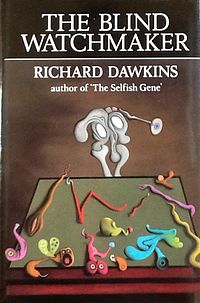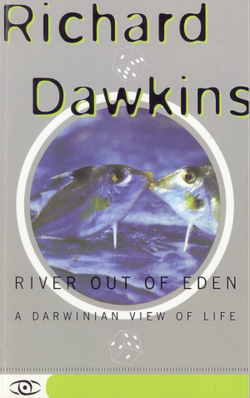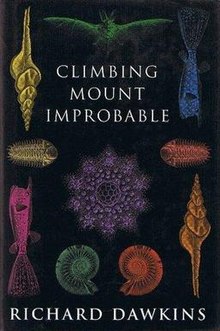Memetics is the study of information and culture based on an analogy with Darwinian evolution. Proponents of memetics, as evolutionary culture, describe it as an approach of cultural information transfer. Those arguing for the Darwinian theoretical account tend to begin with theoretical analogies from existing biological evolutionary models. Memetics describes how ideas or cultural information can propagate, but doesn't necessarily imply a meme's concept is factual.

Natural selection is the differential survival and reproduction of individuals due to differences in phenotype. It is a key mechanism of evolution, the change in the heritable traits characteristic of a population over generations. Charles Darwin popularised the term "natural selection", contrasting it with artificial selection, which is intentional, whereas natural selection is not.

In evolutionary biology, punctuated equilibrium is a theory that proposes that once a species appears in the fossil record, the population will become stable, showing little evolutionary change for most of its geological history. This state of little or no morphological change is called stasis. When significant evolutionary change occurs, the theory proposes that it is generally restricted to rare and geologically rapid events of branching speciation called cladogenesis. Cladogenesis is the process by which a species splits into two distinct species, rather than one species gradually transforming into another.

Richard Dawkins is a British evolutionary biologist and author. He is an emeritus fellow of New College, Oxford, and was Professor for Public Understanding of Science in the University of Oxford from 1995 to 2008. His 1976 book The Selfish Gene popularised the gene-centred view of evolution, as well as coining the term meme. Dawkins has won several academic and writing awards.

The Selfish Gene is a 1976 book on evolution by ethologist Richard Dawkins, in which the author builds upon the principal theory of George C. Williams's Adaptation and Natural Selection (1966). Dawkins uses the term "selfish gene" as a way of expressing the gene-centred view of evolution, popularising ideas developed during the 1960s by W. D. Hamilton and others. From the gene-centred view, it follows that the more two individuals are genetically related, the more sense it makes for them to behave cooperatively with each other.

The Blind Watchmaker: Why the Evidence of Evolution Reveals a Universe without Design is a 1986 book by Richard Dawkins, in which the author presents an explanation of, and argument for, the theory of evolution by means of natural selection. He also presents arguments to refute certain criticisms made on his first book, The Selfish Gene. An unabridged audiobook edition was released in 2011, narrated by Richard Dawkins and Lalla Ward.
In evolutionary biology, fitness landscapes or adaptive landscapes are used to visualize the relationship between genotypes and reproductive success. It is assumed that every genotype has a well-defined replication rate. This fitness is the "height" of the landscape. Genotypes which are similar are said to be "close" to each other, while those that are very different are "far" from each other. The set of all possible genotypes, their degree of similarity, and their related fitness values is then called a fitness landscape. The idea of a fitness landscape is a metaphor to help explain flawed forms in evolution by natural selection, including exploits and glitches in animals like their reactions to supernormal stimuli.

River Out of Eden: A Darwinian View of Life is a 1995 popular science book by Richard Dawkins. The book is about Darwinian evolution and summarizes the topics covered in his earlier books, The Selfish Gene, The Extended Phenotype and The Blind Watchmaker. It is part of the Science Masters series and is Dawkins's shortest book. It is illustrated by Lalla Ward, Dawkins's then-wife. The book's name is derived from Genesis 2:10 relating to the Garden of Eden. The King James Version reads "And a river went out of Eden to water the garden; and from thence it was parted, and became into four heads."

Orthogenesis, also known as orthogenetic evolution, progressive evolution, evolutionary progress, or progressionism, is an obsolete biological hypothesis that organisms have an innate tendency to evolve in a definite direction towards some goal (teleology) due to some internal mechanism or "driving force". According to the theory, the largest-scale trends in evolution have an absolute goal such as increasing biological complexity. Prominent historical figures who have championed some form of evolutionary progress include Jean-Baptiste Lamarck, Pierre Teilhard de Chardin, and Henri Bergson.

The weasel program or Dawkins' weasel is a thought experiment and a variety of computer simulations illustrating it. Their aim is to demonstrate that the process that drives evolutionary systems—random variation combined with non-random cumulative selection—is different from pure chance.

Phyletic gradualism is a model of evolution which theorizes that most speciation is slow, uniform and gradual. When evolution occurs in this mode, it is usually by the steady transformation of a whole species into a new one. In this view no clear line of demarcation exists between an ancestral species and a descendant species, unless splitting occurs. The theory is contrasted with punctuated equilibrium.
The junkyard tornado, sometimes known as Hoyle's fallacy, is an argument against abiogenesis, using a calculation of its probability based on false assumptions, as comparable to "a tornado sweeping through a junk-yard might assemble a Boeing 747 from the materials therein" and to compare the chance of obtaining even a single functioning protein by chance combination of amino acids to a solar system full of blind men solving Rubik's Cubes simultaneously. It was used originally by English astronomer Fred Hoyle (1915–2001) in his book The Intelligent Universe, where he tried to apply statistics to evolution and the origin of life. Similar reasoning were advanced in Darwin's time, and indeed as long ago as Cicero in classical antiquity. While Hoyle himself was an atheist, the argument has since become a mainstay in the rejection of evolution by religious groups.
The Ultimate Boeing 747 gambit is a counter-argument to modern versions of the argument from design for the existence of God. It was introduced by Richard Dawkins in chapter 4 of his 2006 book The God Delusion, "Why there almost certainly is no God".
Many scientists and philosophers of science have described evolution as fact and theory, a phrase which was used as the title of an article by paleontologist Stephen Jay Gould in 1981. He describes fact in science as meaning data, not known with absolute certainty but "confirmed to such a degree that it would be perverse to withhold provisional assent". A scientific theory is a well-substantiated explanation of such facts. The facts of evolution come from observational evidence of current processes, from imperfections in organisms recording historical common descent, and from transitions in the fossil record. Theories of evolution provide a provisional explanation for these facts.
Popularized by Richard Dawkins in The God Delusion, the spectrum of theistic probability is a way of categorizing one's belief regarding the probability of the existence of a deity.

Growing Up in the Universe was a series of lectures given by Richard Dawkins as part of the Royal Institution Christmas Lectures, in which he discussed the evolution of life in the universe.
Coatonachthodes ovambolandicus is a termite-mimicking beetle which lives as a parasite in their nests. It looks roughly like a termite from above, though its legs look like "twisted balloons" rather than real insect legs. This less than accurate emulation can be explained by looking at the beetle from the side rather than down at its dorsum. The beetle's head and leg-bearing thorax are minuscule relative to its large abdomen. This part of the body is bent back towards the anterior (head) end, covering the rest of its body. It is the abdomen alone which is visible from above, providing a deceptive 'umbrella' that looks like a termite. The rear end thus acts as the termite 'head', and its appendages are composed of moving flaps attached to the abdomen's upper side.

Dawkins vs. Gould: Survival of the Fittest is a book about the differing views of biologists Richard Dawkins and Stephen Jay Gould by philosopher of biology Kim Sterelny. When published in 2001 it became an international best-seller. A new edition was published in 2007 to include Gould's The Structure of Evolutionary Theory finished shortly before his death in 2002, and recent works by Dawkins. The synopsis below is from the 2007 publication.

The following list of publications by Richard Dawkins is a chronological list of papers, articles, essays and books published by British ethologist and evolutionary biologist Richard Dawkins.












